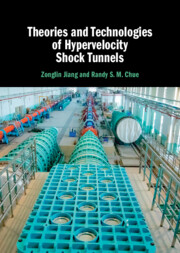Book contents
- Theories and Technologies of Hypervelocity Shock Tunnels
- Theories and Technologies of Hypervelocity Shock Tunnels
- Copyright page
- Contents
- Preface
- 1 Introduction
- 2 Shock-Wave Relations and Aerothermodynamic States
- 3 Heated Light-Gas High-Enthalpy Shock Tunnels
- 4 Free-Piston-Driven High-Enthalpy Shock Tunnels
- 5 Detonation-Driven High-Enthalpy Shock Tunnels
- 6 Theory and Methods for Long-Test-Duration Shock Tunnels
- 7 Methods for Designing High-Enthalpy Flow Nozzles
- 8 Aerothermodynamic Testing and Hypersonic Physics
- Index
- References
6 - Theory and Methods for Long-Test-Duration Shock Tunnels
- Theories and Technologies of Hypervelocity Shock Tunnels
- Theories and Technologies of Hypervelocity Shock Tunnels
- Copyright page
- Contents
- Preface
- 1 Introduction
- 2 Shock-Wave Relations and Aerothermodynamic States
- 3 Heated Light-Gas High-Enthalpy Shock Tunnels
- 4 Free-Piston-Driven High-Enthalpy Shock Tunnels
- 5 Detonation-Driven High-Enthalpy Shock Tunnels
- 6 Theory and Methods for Long-Test-Duration Shock Tunnels
- 7 Methods for Designing High-Enthalpy Flow Nozzles
- 8 Aerothermodynamic Testing and Hypersonic Physics
- Index
- References
Summary
Based on detonation-driven shock tunnels, key issues that play important roles in extending the test time are introduced in this chapter, and the corresponding solutions are proposed, evaluated, and discussed in detail, including the tailored-interface condition, the shock–boundary-layer interaction at the end of the driven section, and the precursor shock damping in the vacuum tank. The research work on these issues was carried out to find out the flow physics and application methods to improve the high-enthalpy shock tunnel for meeting the test time requirement for supersonic combustion and scramjet engine experiments. With application of the aforementioned theories and methods to the high-enthalpy shock tunnel, a large-scale detonation-driven hypersonic flight-duplicated shock tunnel (the JF-12 shock tunnel) was successfully developed, which can provide test times of more than 100 microseconds and is capable of duplicating hypersonic flight conditions for Mach numbers of 5–9 at altitudes of 25–50 km.
- Type
- Chapter
- Information
- Theories and Technologies of Hypervelocity Shock Tunnels , pp. 165 - 191Publisher: Cambridge University PressPrint publication year: 2023



